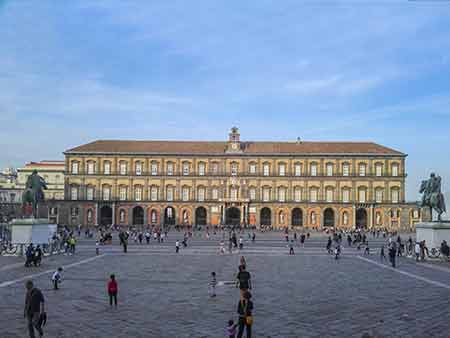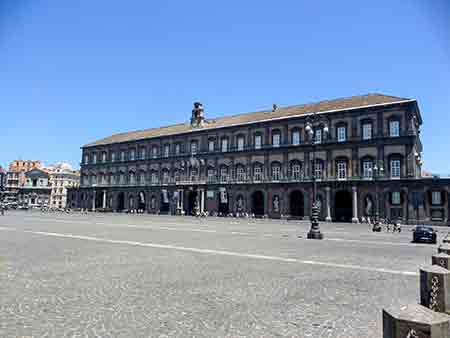History of Naples, Greeks and Romans, 900 BC(BCE)-476 AD(CE)
The first inhabited center: Partenope
The history of Naples began in the 9th century BC (BCE), when the Greeks settled the little island of Megaride, and they created the first inhabited center: Parthenope.
Neapolis Community Foundation
In 470 BC Cumae (Greek colony) founded Neapolis (from the Greek new town) on the old inhabited center which changed its name from Parthenope to Paleopolis (from the Greek ancient city).
Naples and the Roman Empire
In 326 BC the Romans conquered Naples. During the empire the Neapolitan city, with its enchanting landscapes and natural thermal baths, became a holiday destination for the Roman nobles and the many writers of that time: Virgil, Cicero, Horace etc.
In 79 A.D. there was the eruption of Mount Vesuvius, the cities of Pompeii, Herculaneum, Stabia and Oplontis were destroyed.
History of Naples, the Barbarian invasions, 476-536 AD(CE)
In 476 A.D. the entire Italian peninsula was conquered by the Barbarians (Germanic people).
The Byzantines and the Duchy of Naples, 536 - 1137 AD(CE)
The city of Naples in 536 AD(CE) was conquered by the Byzantines, the Eastern Roman Empire.
For almost a century Goths, Vandals and Lombards, Germanic peoples, tried to conquer the city of Naples but the Byzantines resisted.
Around 660 (date uncertain) the Duchy of Naples was founded.
Initially the duchy was simply a Byzantine province, commanded by a military governor, then the nobles of that time turned the Duchy of Naples into an autonomous state and also they managed to make the post of Duke hereditary.
Kingdom of Sicily, 1130 AD(CE) - 1816 AD(CE)
Kingdom of Sicily and the Normans from Northern Europe
The kingdom of Sicily was built in 1130 when Roberto d 'Altavilla, a Norman leader and duke of Apulia and Calabria, in 1072 went down to Sicily and chasing away the Saracens he created the Great County of Sicily. He named his younger brother Ruggero Great Count.
In 1127 Guglielmo d 'Altavilla, last Count of Apulia and Calabria, died without heirs, so its lands passed to his cousin Ruggero II, the last Grand Count of Sicily, who in 1130 united both counties, so the kingdom of Sicily was founded.
Fter years, in 1137, the Normans also conquered the duchy of Naples thus expanding the Kingdom of SIcily.
History of Naples and the Swabians of Frederick II.
The kingdom of Sicily in 1194 was conquered by the Swabians, a Germanic people. During their domination we cannot fail to remember the king of Sicily Frederick I, better known as Frederick II, emperor of the Holy Roman Empire, who is considered one of the best sovereigns in Europe. A man of great culture who founded the Studium, the oldest university in Europe, known today as the Federico II University of Naples.
Naples conquered by the Angevins (France)
The Angevins led by Charles of Anjou, son of the king of France Louis VIII, in 1266 conquered southern Italy and Sicily, proclaiming the United Kingdom to the Crown of Sicily and the new King decided to move the capital, from Palermo to Naples.
Kingdom of Sicily: the Angevin architectural works
The Kingdom of Sicily, during the Angevin domination, had a great evolution, the French left traces of their passage with the construction of majestic monuments, castles, basilicas, churches and much more.
In 1235 the construction of the Basilica of Saint Lorenzo Maggiore began
In 1272 Charles of Anjou, after having conquered the kingdom of Sicily, he decided to move the Capital from city Palerm to that of Naples and build a new castle near the sea. Thus he began the construction of the New Castle (in italian Maschio Angioino), the medieval castle in Plebiscite square (Piazza del Plebiscito).
In 1283 the construction of the Basilica of Saint Domenico Maggiore began
Kingdom of Naples, 1302 - 1816 AD(CE)
Kingdom of Naples, the foundation in 1302 AD(CE)
The kingdom of Naples was founded in 1302 with a war that lasted 20 years. In fact in 1282 in Sicily there was the revolt of the Sicilian Vespers, who no longer wanted the Angevins as ruling monarchs, so the nobles of the island, led by Alaimo from Lentini, offered the crown of Sicily to Peter III of Aragon, in exchange they asked support to chase the French rulers out.
After 20 years, on 31 August 1302, the peace treaty of Caltabelotta was signed which endend the wars but the kingdom of Sicily was divided in two parts, the Aragonese obtained the Sicily and the Angevins retiring on the continent they created the new kingdom of Naples.
"Kingdom of Naples" was not the real name, in fact at that time the official name was "Regnum Siciliae citra Pharum" (Kingdom of Sicily on this side of the Lighthouse), while the official name of the kingdom of Sicily was "Regnum Siciliae ultra Pharum" (Kingdom of Sicily beyond the lighthouse).
In those years Naples has became one of the most important cultural centers of Europe and it was the destination for the greatest artists and poets of that period such as the Petrarch and Boccaccio, Simone Martini and Giotto.
In 1310 the construction of the church of St Clare began. Sancia of Majorca, wife of the king of Naples Robert of Anjou, was very devoted to the cloistered life, so in 1310 her husband decided to have a new church because as the wife of the King she could not respond to vocation. The entire complex was completed in 1328 but was consecrated to St Clare only in 1340.
In the second half of the 1700s the church was restored in the Baroque style and its appearance was thus radically changed.
During the Second World War the roof of the church was destroyed by an aerial bombardment which caused a fire that lasted almost 2 days. Unfortunately the fire ruined part of the building and all the frescoes. After about 10 years the basilica of St Clare was restored again, but this time it was decided to return to the Gothic style.
In 1313 the Basilic of Saint Mary of the Assumption (Cathedral of Naples) was completed.
On the Vomero hill in 1329 the construction of the Palatium castrum (Castel sant' Elmo) began.
Kingdom of Naples: the Aragoneses of Spain
In 1442 the Angevins were definitively defeated by the Aragonese, who also conquered southern Italy and Alfonso I of Aragon, king of Sicily, also became king of Naples. The 2 kingdoms remained independent but under the same ruler.
From that moment all the kings who owned both kingdoms at the same time took the title of "Rex utriusque Siciliae" (King of the two Sicilies), not to be confused with the kingdom of the two Sicilies established in 1816. This title was adopted because the monarch could use the same name for both kingdom. Only in the future in 1759 Ferdinand of Borboun did not use this title, in fact he was Ferdinand IV king of Naples and Ferdinand III king of Sicily.
During the Aragonese dominion the history of the city of Naples had a great economic development. Among the buildings builts by Aragonese we can mention the marble arch of the New Castle (Maschio Angioino), the church of S. Anna dei Lombardi, that of S. Angelo al Nilo, the Porta Capuana (one of the gates of Naples), the Aragonese castle of Ischia and that of Baiae.
The Aragonese often defended the kingdom from the insurrection mounted by the barons and against the Angevins who tried to claim the kingdom, in fact in 1495 Charles VIII of Valois, king of France, conquered the kingdom of Naples, but immediately after a few months king Ferdinand II of Aragon reconquered it.
In 1498 Charles VIII of Valois died leaving the kingdom of France without heirs, so his cousin Louis XII (Valois-Orléans) by marrying the widow of the old sovereign became, in 1501, the new King of France, so he tried and reconquered the Kingdom of Naples, so as the two kingdom was not so close together he adopted the viceroy system. Also on this occasion the Aragonese, with Ferdinand III of Aragon, regained possession of the kingdom in 1504.
Kingdom of Naples, the viceroyalty of the Habsburgs of Spain
After the reconquest of the kingdom of Naples Ferdinand III of Aragon also adopted the viceroy system.
In 1516, Charles IV of Habsburg, grandson of Emperor Maximilian I of the Holy Roman Empire, became king in the place of his mother Joan of Aragon, unable to reign due to insanity. Even if the family was the same, the dynasty changed surname to the Habsburgs of Spain.
In 1600 the construction of the royal palace of Naples began.
In 1606 Michelangelo Merisi (Caravaggio), went to the Neapolitan city where he made many works.
In 1631 there was an eruption of Vesuvius which destroyed many towns. There were more than 3000 victims.
History of Naples and the Neapolitan republic
In 1647, there was the revolts of Masaniello (Tommaso Aniello d'Amalfi), the Neapolitan republic was founded. But after a few months Don Giovanni d’Austria (son of the Spanish king Philip IV) re-established the Spanish domination with the Austrian viceroy.
The Kingdom of Naples and the Austrian vice realm(Aragonese)
In 1700 the King of Spain Charles II of Habsburg died without heirs, so the War of the Spanish Succession began which the Bourbons of France against the Habsburgs of Austria with their respective allies.
After a few years, 2 peace treaties were stipulated: Utrecht, in 1713, and Rastatt, in 1714, thanks to which the Spanish kingdom was divided among the major European powers and Charles VI of Habsburg was chosen as the new king of Naples.
The kingdom of Naples and the Bourbons of Spain
The kingdom of Naples and the Bourbons of Spain
In 1734 there was the Polish succession war, during which Charles of Bourbon took this opportunity to conquer first of all the Kingdom of Naples then that of Sicily, thus becoming Charles VII King of Naples and Charles III King of Sicily. Later in 1738 with the stipulation of the Treaty of Vienna the 2 conquered kingdoms had to be independent but under a single sovereign. So even the king Carles of Borboun adopted the title of Rex utiusque Sicilia (king of the two Sicilies) becoming Charles III king of Naples and king of Sicily. Attention, the kingdom of the two Sicilies was established after the Napoleonic conquests in 1816, in this case to be king of the two Sicilies is just a formal title, in order to use the same name for both realms.
The kingdom of Naples, during the Bourbon domination, had a period of great industrial, scientific and economic development.
King Charles immediately decided to stay in the royal palace of Naples and he ordered to restore it and expand it.
In 1737 the Royal Saint Charles theater was inaugurated.
In 1738 the construction works of the Royal palace of Portici began.
In the same year Charles of Bourbon needed a place for the family works of his mother Elisabetta Farnese, so he ordered to built the Royal palace of Capodimonte.
In 1739 the porcelain manufactory was established in Capodimonte.
Between 1747 and 1751 the Eighteenth-Century Pharmacy (Farmacia settecentesca) was built in the hospital for the incurable.
In 1751, the construction of the royal hotel of the poor began, to accommodate the disadvantaged and homeless of the kingdom and to ensure safety on the streets. But it was also built for the re-education of prisoners and to teaching of a job to the orphans.
In 1752 Charles of Bourbon commissioned the architect Luigi Vanvitelli to build the Royal Palace of Caserta. The king wanted a residence as beautiful as that of the French cousins who owned the Palace of Versailles.
In 1753 the construction of Carolino aqueduct began and it was completed and inaugurated in 1762. It's a majestic work that, from the sources of the Fizzo springs, on Mount Taburno in the province of Benevento, runs through about 40 km to take the water and to feed the fountains and the gardens of the royal palace of Caserta.
In 1757 Charles of Bourbon ordered the construction of the Carolino forum, the current boarding school in the shape of an exedra in Piazza Dante.
In 1759 the king of Spain Ferdinand VI died and Charles of Bourbon with his eldest son Philip left to reign the Iberian country.
Thus the kingdom of Naples and Sicily passed to Ferdinand who at the age of 8 became Ferdinand IV king of Naples and Ferdinand III king of Sicily, the new sovereign did not adopt the title of Rex Utriusque Siciliae.
In 1770 the Ironworks Complex was born in Calabria
In 1778 Ferdinand IV of Bourbon decided to transform the San Leucio complex into a silk factory.
In the same year the beach of Chiaia was transformed into the royal villa, then transformed into a municipal villa.
In 1783 the Royal Arsenal was founded, a shipyard in Castellammare di Stabia to repair and construction of military ships.
In 1787 the Royal estate of Carditello was built, one of the Bourbon residences used as a hunting and horse breeding place.
The History of Naples and Neapolitan republic
In 1799 there was the birth of the Neapolitan Republic, but in the same year the Bourbons managed to reconquer the city of Naples.
In 1807 the Royal Botanical Garden of Naples was established
The kingdom of Naples and Napoleon Bonaparte
In 1806 the kingdom of Naples was conquered by Napoleon Bonaparte who appointed his brother Joseph as the new king. The Bourbons were forced to retreat to Sicily.
After a few years the French emperor also conquered Spain, so Joseph Bonaparte left to go to reign the Iberian peninsula. Thus the kingdom of Naples was assigned to the new sovereign Gioacchino Murat, Napoleon's brother-in-law.
The kingdom of the two Sicilies and the Bourbon restoration
The kingdom of the two Sicilies was established in 1816 after the congress of Vienna (1815) decided to give back all lands conquered by Napoleon to the absolute sovereigns of Europe, so the kingdom of Naples was returned to Ferdinand IV of Bourbon who a year later founded the kingdom of the two Sicilies, thus the two realms was united and the king took the name of Ferdinand I king of two Sicilies.
In 1816 the construction of Plebiscito Square and the basilica of St. Francis of Paola began.
In the same year, on the Vomero hill the King bought and expanded for her wife Lucia Migliaccio the Villa Floridiana, the beautiful park with a terrace overlooking Naples.
In 1839 the first railway of the Italian peninsula was inaugurated, which connected Naples and the city of Portici. Now in this municipal one finds the Pietrarsa museum, an exhibition of steam locomotives of the time.
In 1841 the Vesuvian observatory was founded and it was inaugurated in 1845, when the VII Congress of Italian Scientists was held in Naples.
The end of the kingdom of the two Sicilies
The kingdom of the two Sicilies came to the end in 1861, when, after the expedition of Garibaldi's thousand, in 1860, and the military intervention of Piedmont, Vittorio Emanuele II of Savoy, king of Sardinia, also conquered the kingdom of Two Sicilies and thus was proclaimed, on March 17 1861, the Kingdom of Italy, a Constitutional monarchy.
Between 1887 and 1890 the construction of the Umberto I gallery began, built during the period of the Neapolitan rehabilitation, demolishing some buildings in that area to solve hygiene and health problems caused by the spread of cholera.
In 1889 the Chiaia funicular was built.
In 1899 the cumana railway was built.
On 2 June 1946 a referendum was called to choose between monarchy and republic, so the kingdom of Italy became the new Italian Republic.
Legends of Naples, the mermaid Parthenope and the Egg Castle
The mermaid Parthenope
Naples is also called the city of Parthenope, that term derives from the Greek word and it means virgin, the mermaid who, afflicted for not been able to charm Ulysses with her song, she threw herself from the rocks of Capri Island or Li Galli, near Positano (uncertain). The body of the enchantress was transported by the sea to the islet of Megaride, where now one find the Egg Castle, a fortress, the oldest in the city.
The legend of the Egg Castle
The legend of Egg Castle has it of Virgil, a Roman poet of the 1st century. B.C. (B.C.E.), but for the Neapolitans, in the past, he was known as an alchemist, who hid an enchanted egg in the foundations of the castle, and he stated that if it were lost or destroyed the city of Naples would suffer very powerful natural disasters. That is why this fortress is called Egg Castle.
During the 14th century there was the fall of an arch that supported the entrance to the castle, thus the queen Giovanna I of Anjou had to swear that she had replaced the egg as the Neapolitan were particularly very superstitious, thus they panicked.



















